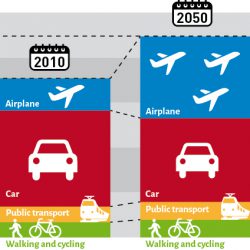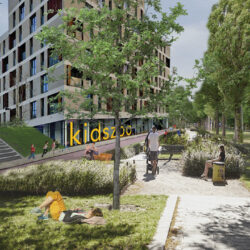'Transport poverty' is a new buzzword. I recommend no longer using this. There is certainly poverty in the Netherlands, because we have food banks and thirty-two thousand 'registered' homeless people, in reality more. Six percent of Dutch population lives below… Read More
Logistics cause 11% to 12% of global CO2 emissions. Road transport accounts for around two thirds of this. Even with the fastest possible switch to electric trucks, the logistics industry is not on track to reduce greenhouse gas emissions to zero by 2050. In Europe, 8% of trucks would still run on diesel mid-century.
Up to 2050, no less than one-fifth of the permitted greenhouse gas emissions in Europe will come from trucks, concluded T&E’s scenario study Addressing the heavy-duty climate problem. On top of changing the sales trajectory of trucks from diesel to electric as fast as possible, greenhouse gases from logistics must be reduced further by reducing the growth in lorry kilometres.
Rail and inland shipping are stating that they can cope with the growth. After all, they are cleaner per tonne-kilometre. However, little cargo can be transferred from road to rail and water because their markets hardly overlap with those of road freight. In Europe, the road share has even been increasing (from 47% in 1995 to 53% in 2020), despite decades of political desire to increase the market share of rail and inland shipping. Wishful thinking can be stubborn.
More efficient logistics is therefore needed to achieve the Paris goals. This has been supported by the industry in the 2019 Dutch Climate Agreement. Each year, logistics efficiency must improve by 2%. As a result, the number of truck kilometres in the Netherlands should fall slightly in the coming years, as the annual efficiency improvement of 2% is greater than the expected growth in truck kilometres of about 1.5% per year.
The logistics companies must make different choices. Purchasing closer to home saves many transport kilometres. Reducing return packages reduces the number of truck miles. Less just-in-time makes fuller trucks possible. More distribution centres mean shorter distances to customers. A smaller assortment on the store shelves ensures more efficient logistics. In addition to these adjustments by logistic companies, local governments can concentrate distribution centres at only a few locations, which makes it easier to bundle freight during delivery and distribution. In short, there are many opportunities for more efficient logistics, which can halt the growth in truck kilometres.
It all starts with figures about the transport flows and the CO2 footprint. Useful tools are available for this, such as BigMile. Twenty years ago, a map with all transport flows for a cup of strawberry yoghurt caused excitement and a call for less transport. The construction industry can reduce lorry kilometres by 14% by using a construction hub and return freight, according to research by TNO. The shipping industry is at the steering wheel of trucking and should head for sustainable logistics.



